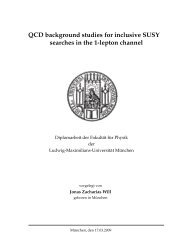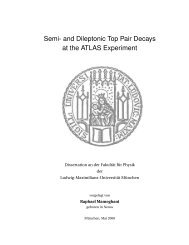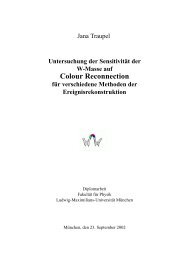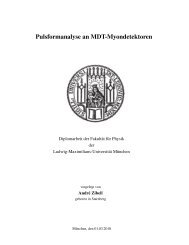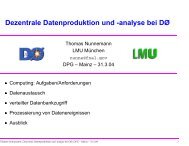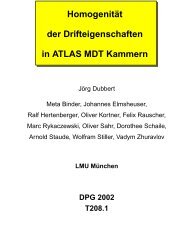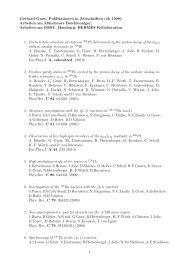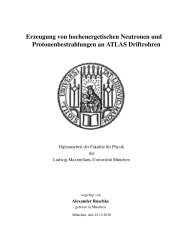development of micro-pattern gaseous detectors – gem - LMU
development of micro-pattern gaseous detectors – gem - LMU
development of micro-pattern gaseous detectors – gem - LMU
You also want an ePaper? Increase the reach of your titles
YUMPU automatically turns print PDFs into web optimized ePapers that Google loves.
54 Chapter 4 Energy Resolution and Pulse Height Analysis<br />
Uin = Qdet<br />
Cdet<br />
= Qcoup<br />
Ccoup<br />
(4.11)<br />
where Qdet is the part <strong>of</strong> the total charge Qtot that remains on the anode. Therefore the total charge<br />
that was generated by primary ionizing particle and amplified by the three GEM foils, is divided in:<br />
Qtot = Qdet + Qcoup<br />
from these two equations one derives an expression for the charge on the coupling capacitor:<br />
Qcoup = Qtot<br />
Cdet<br />
Ccoup<br />
Uout<br />
=<br />
+ 1 FCV<br />
(4.12)<br />
(4.13)<br />
The pulse height Uout is connected to the fraction <strong>of</strong> charges Qcoup via the charge-to-voltage conversion<br />
factor FCV <strong>of</strong> the charge sensitive preamplifier. The Canberra has a conversion factor <strong>of</strong><br />
FCV = 1 V/pC and the conversion factor <strong>of</strong> the ELab preamp is 0.83 ± 0.04 V/pC (see Ch. 3.4.3).<br />
The amplification factor <strong>of</strong> the CATSA82 preamplifier has not been determined since its coupling<br />
capacity Ccoup = 50 nF results in less gain.<br />
As the flash ADC records data in a 12 bit range with an acceptance <strong>of</strong> ±0.5 mV one can identify a<br />
scaling factor mADC:<br />
mADC = 0.244<br />
mV<br />
ADC channel<br />
Using this we transform from the recorded pulse height to the detected charges Qcoup.<br />
charge [pC]<br />
1<br />
0.9<br />
0.8<br />
0.7<br />
0.6<br />
0.5<br />
0.4<br />
0.3<br />
0.2<br />
0.1<br />
Δ U<strong>gem</strong>1=<br />
315 V<br />
Δ U<strong>gem</strong>2=<br />
335 V<br />
Δ U<strong>gem</strong>3=<br />
355 V<br />
Qcoup<br />
cm<br />
kV<br />
Edrift<br />
= 1.25<br />
cm<br />
kV<br />
Etran1,2<br />
= 2.00<br />
Eind<br />
vs # Strips<br />
cm<br />
kV<br />
= 1.67<br />
χ 2 / ndf 2.842 / 3<br />
p0 0.4629 ± 0.06472<br />
p1 0.5055 ± 0.1228<br />
Ar:CO2<br />
93:7 @ 1 bar<br />
Canberra 2004<br />
p0/(p1*x+1)<br />
0<br />
0 1 2 3<br />
# strips<br />
4 5<br />
p0/(0.0876*x+1.124)<br />
(4.14)<br />
Figure 4.24: Amount <strong>of</strong> collected charge that reaches the preamplifier as a function <strong>of</strong> the number <strong>of</strong> readout<br />
strips being coupled together. The decreasing pulseheight is due to increasing detector capacity as a function<br />
<strong>of</strong> readout strips.<br />
In order to pro<strong>of</strong> equation 4.13 the data taken with the Canberra2004 preamplifier is transformed as<br />
it is shown in Fig. 4.24. A fit function with two free parameters is applied to the data (red line in<br />
Fig. 4.24) and yields a strip capacity C PCB<br />
strip <strong>of</strong>:



